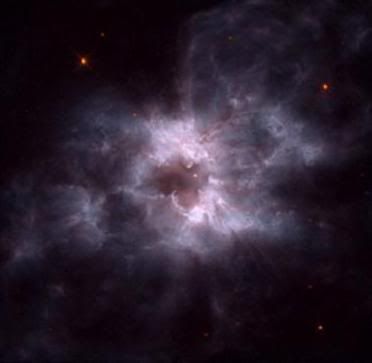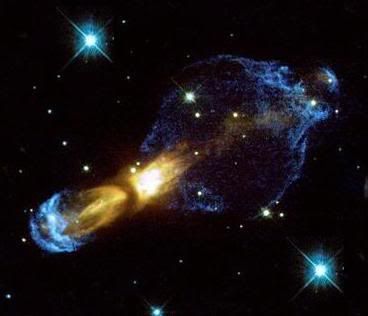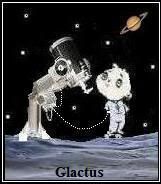Post by glactus on Oct 6, 2011 1:07:45 GMT
The Calabash Nebula, also known as the Rotten Egg Nebula is a protoplanetary nebula 1.4 light years long and located some 5,000 light years from Earth in the constellation of Puppis. Violent gas collisions that produced supersonic shock fronts in a dying star are seen in a new, detailed image from NASA's Hubble Space Telescope.

The Rotten Egg Nebula
The object is sometimes called the Rotten Egg Nebula because it contains a relatively large amount of sulfur. The densest parts of the nebula are composed of material ejected recently by the central star and accelerated in opposite directions. This material, shown as yellow in the image, is zooming away at speeds up to one and a half million kilometers per hour (one million miles per hour). Most of the star's original mass is now contained in these bipolar gas structures.

New Hubble image of the Rotten Egg Nebula
A team of Spanish and US astronomers used NASA's Hubble Space Telescope to study how the gas stream rams into the surrounding material, shown in blue. They believe that such interactions dominate the formation process in planetary nebulae. Due to the high speed of the gas, shock-fronts are formed on impact and heat the surrounding gases. Although computer calculations have predicted the existence and structure of such shocks for some time, previous observations have not been able to prove the theory.

Space art-The Astronomy club looking at the Rotten Egg nebula
This new Hubble image used filters that only let through light from ionized hydrogen and nitrogen atoms. Astronomers were able to distinguish the warmest parts of the gas heated by the violent shocks and found that they form a complex double-bubble shape. The bright yellow-orange colors in the picture show how dense, high-speed gas is flowing from the star, like supersonic speeding bullets ripping through a medium in opposite directions. The central star itself is hidden in the dusty band at the center.
Much of the gas flow observed today seems to stem from a sudden acceleration that took place only about 800 years ago. The astronomers believe that 1,000 years from now, the Calabash Nebula will become a fully developed planetary nebula, like a butterfly emerging from its chrysalis.

Credits: These are non copywrite images
Text by Wikipedia
Space art by Glactus

The Rotten Egg Nebula
The object is sometimes called the Rotten Egg Nebula because it contains a relatively large amount of sulfur. The densest parts of the nebula are composed of material ejected recently by the central star and accelerated in opposite directions. This material, shown as yellow in the image, is zooming away at speeds up to one and a half million kilometers per hour (one million miles per hour). Most of the star's original mass is now contained in these bipolar gas structures.

New Hubble image of the Rotten Egg Nebula
A team of Spanish and US astronomers used NASA's Hubble Space Telescope to study how the gas stream rams into the surrounding material, shown in blue. They believe that such interactions dominate the formation process in planetary nebulae. Due to the high speed of the gas, shock-fronts are formed on impact and heat the surrounding gases. Although computer calculations have predicted the existence and structure of such shocks for some time, previous observations have not been able to prove the theory.

Space art-The Astronomy club looking at the Rotten Egg nebula
This new Hubble image used filters that only let through light from ionized hydrogen and nitrogen atoms. Astronomers were able to distinguish the warmest parts of the gas heated by the violent shocks and found that they form a complex double-bubble shape. The bright yellow-orange colors in the picture show how dense, high-speed gas is flowing from the star, like supersonic speeding bullets ripping through a medium in opposite directions. The central star itself is hidden in the dusty band at the center.
Much of the gas flow observed today seems to stem from a sudden acceleration that took place only about 800 years ago. The astronomers believe that 1,000 years from now, the Calabash Nebula will become a fully developed planetary nebula, like a butterfly emerging from its chrysalis.
Credits: These are non copywrite images
Text by Wikipedia
Space art by Glactus


